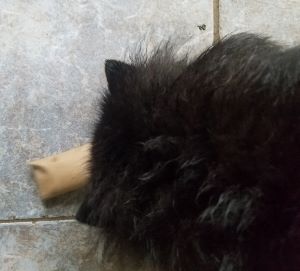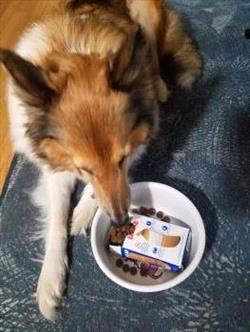Toilet paper cardboard enrichment

This dog is having fun trying to get kibble out of a toilet paper tube taped shut.
Photo by VIN.
What is Enrichment and Why is it Important for Senior Dogs?
Enrichment is offering experiences and opportunities to animals to encourage healthy natural behaviors and enhance physical and emotional welfare. Enrichment is often broken into two broad categories: environmental and social. Environmental enrichment alters the animal’s space either by making changes to the environment itself or by adding novel items such as toys, feeding puzzles, exercise, and things to smell and explore. Social enrichment involves offering positive social experiences for the animal with people or other animals.
Enrichment is important for all species of animals, including people! Sometimes we enrich our lives and our animal’s life without even noticing, such as going for walks outside or eating a yummy treat. Sometimes enrichment takes planning, such as a vacation or assembling food puzzles for your dog. Understand that what is considered enrichment should be from your dog’s perspective and each dog needs to be able to choose if they want to participate or interact with the enrichment item or not. We can entice dogs to participate by offering their favorite treats or petting in their favorite spots but ultimately it will still be their choice to interact or not.
Dogs can have several age-related diseases that can result in behavior changes and welfare concerns, such as arthritis, dental disease, cancer, diabetes, and other endocrine diseases. Additionally, dogs can develop canine cognitive dysfunction, a syndrome that is similar to Alzheimer’s disease in humans. Pain is more likely to occur in senior dogs with age-related diseases, leading to decreased activity, increased anxiety, restlessness, and occasionally aggression. Due to these age-related challenges, we should find ways to enrich their lives and help manage these conditions. While senior dogs may not be able to participate in much physical enrichment, such as long walks, other forms can be mentally stimulating and tiring.
If you have noticed behavioral changes in your senior dog, work with your veterinarian to determine if there is an underlying medical condition that may be causing the behavior. You should also discuss your dog’s weight and nutrition with your veterinarian to keep them at a healthy weight and as comfortable as possible.
By working with your veterinarian to manage age-related health conditions and providing individual and age-appropriate enrichment, you can enhance your pet’s quality of life and improve your bond with your aging dog.
Collie eating enrichment

This 13-year old dog is eating her breakfast from a small box filled with kibble.
Photo by VIN.
Enrichment Ideas for Senior Dogs
- Shorter walks outside – There is nothing like the great outdoors! Physical exercise, opportunities for social interaction, and new things to see and smell! Your walks may need to be a lot shorter than they were in younger years, but they are still beneficial. Just make sure to monitor how your pet is handling the walk and not to push your dog too far. Even sitting outside or taking a short walk focused on sniffing (sniff walk) can be enriching.
- Puzzle Feeders – There are many different puzzle feeders available for dogs. You can shop online, in pet stores, or make them yourself! You can use some or all of your pet’s regular diet in the puzzle feeders, and you can also use special treats. For a simple DIY puzzle feeder, put some kibble in a plastic bottle without the lid, or save toilet paper or paper towel tubes and put kibble inside with the ends folded. Just make sure your dog doesn’t try to eat the bottle or cardboard! Another simple idea is to feed your dog from a muffin tin; you can even put tennis balls on top of the muffin tin to make it more challenging. Sometimes, you can freeze food in puzzle feeders to make them last longer.
- Snuffle Mats – Snuffle mats look like extra shaggy rugs. You can purchase them or you can make them yourself. They can be used as a food puzzle or you can use them with scents. If you are adding scent, make sure that it is safe for dogs. Certain essential oils such as cinnamon, tea tree, peppermint, and wintergreen are not safe. Scents such as coconut, vanilla, ginger, and valerian are safe. Additionally, some dogs respond to catnip, and it can help them relax. Snuffle mats encourage sniffing and encourage normal foraging behaviors.
- Scavenger Hunts – Hide treats, food items, and toys around the house or yard. Some dogs enjoy playing hide and seek with their favorite toys. Hide items in safe places. Hide items near places the dog frequents, such as by their bed or water bowl, and then expand from there.
- Positive Reinforcement Training – An old dog absolutely can learn new tricks! Positive reinforcement training will improve your bond with your pet at any life stage, and senior dogs are no exception. Positive reinforcement is rewarding your dog, usually with a food treat, for doing what you ask. Clicker training is a great way to use positive reinforcement to train your dog. You can teach useful behaviors such as sit, lay down, crate, and stay, or you can teach fun behaviors to your dog such as shake, target, speak, fetch. Positive reinforcement training is a great tool for senior dogs because it is mentally stimulating but does not require physical exertion.
- Socialize with other Senior Dogs or Calm dogs – If your dog enjoys the company of other dogs, arrange for play dates with other calm or senior dogs. Make sure that your dog enjoys this experience by monitoring their body language. Your dog should choose to engage with the other dogs, have loose body language, and be relaxed.
When it comes to enrichment, you can find something for all senior dogs no matter what their health or mobility status.